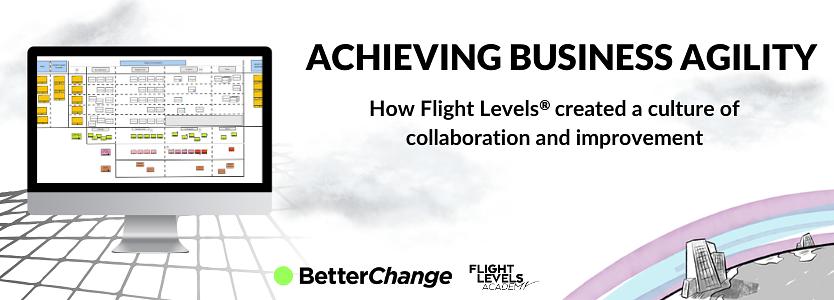
Introduction
Step into the bustling heart of a city renowned for its blend of rich history and pioneering technology, where a vibrant online legal services company is making waves. Nine years young and already flourishing, this company achieved profitability after its first year. Yet, despite its rapid growth and early success, it faced a daunting challenge: maintaining its innovative spirit and swift expansion while ensuring operational stability and fostering teamwork among its growing ranks. This is the story of how we transformed our dynamic enterprise using Flight Levels®, instilling predictability and fostering a robust culture of collaboration.
The Catalyst for Change
It all began with a startling week-long outage. For a company that thrived online, this was a nightmare scenario. It wasn't just about lost revenue; it was a wake-up call to the core of the business. The leadership realised the urgent need for a seismic shift in how work was managed.
To get started we embarked on what I call an 'initial exploration'. This involved dissecting the company's operations from four perspectives; teams, individuals, leadership, and cultural dynamics. During this five-day exploration, we peeled back the layers of a complex work environment, revealing both challenges and opportunities. The findings revealed a vibrant culture and a committed team, but also highlighted a crippling load of technical debt and a lack of clear priorities that needed immediate attention.
Part of the exploration involved understanding the culture of the organisation using the Competing Values Framework, which provided us with insights into the dominant cultural values within the company. Our analysis revealed a strong inclination towards clan and adhocracy cultures, which emphasise a family-like, informal environment and with innovation at its heart. This was crucial because it meant the organisation was naturally predisposed to adapt and thrive in an agile and lean transformation setting.
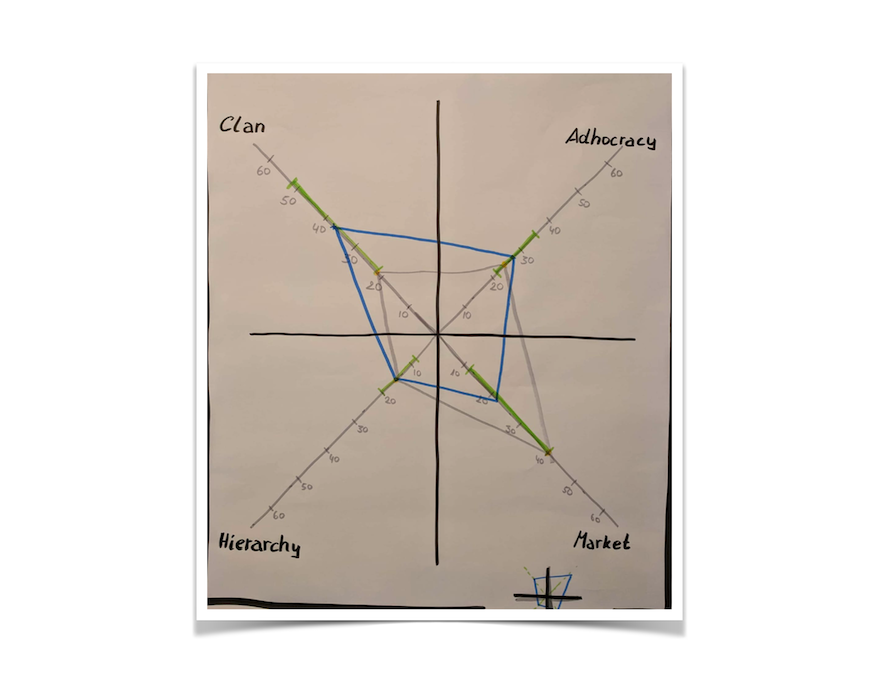
The CVF profile showing a Clan & Adhocracy Culture (the blue shape).
With these cultural insights, we tailored our Flight Levels® implementation to leverage these existing strengths, enhancing our ability to innovate and collaborate across various departments and teams. We avoided the pitfalls of imposing rigid structures that would clash with our inherent cultural dynamics, instead fostering an environment where innovation could flourish within the structured guidance of a Flight Levels 2 System.
Visualising the Change
We began the journey by visualising the workflow through the implementation of a Flight Level 2 System. This wasn't just any organisational tool or technique; it served as the canvas where all our work was painted visibly, displaying projects from inception all the way through to completion.
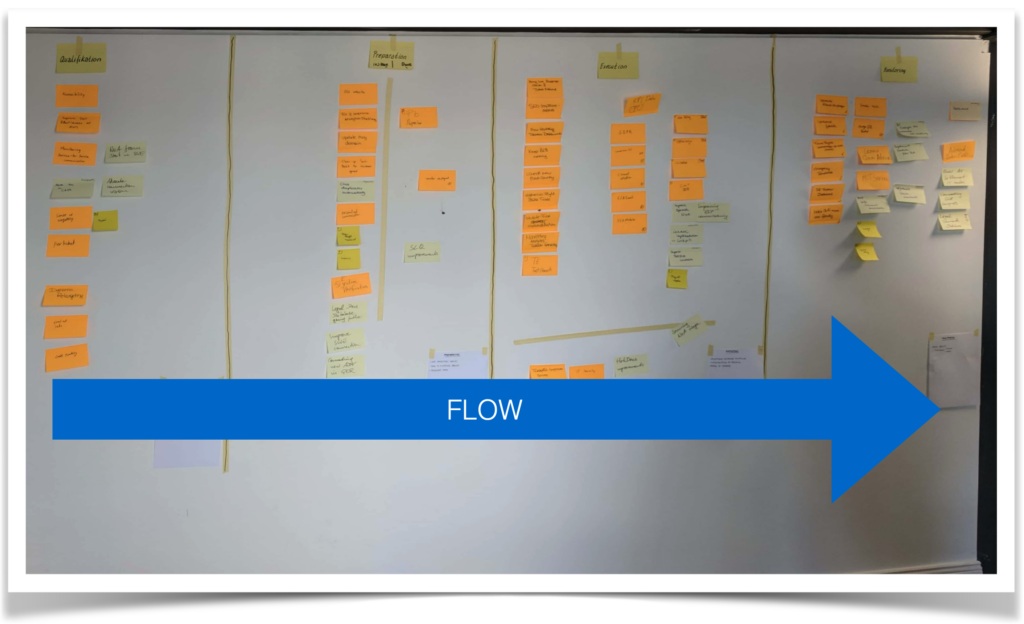
The first draft of the Level 2 board. Very simple initially, but enough to get started.
With this new visualisation, the teams could see, for the first time, both the forest and the trees. This clarity allowed us to understand where efforts were being directed and, more importantly, where they ought to be channelled to maximise impact.
Fostering Collaboration: The Heart of Agile Interactions
The informal networks that had once supported the interactions between teams and departments were no longer effective. This was particularly evident as the company struggled with transparency and communication across departments. Implementing a Flight Level 2 System provided the environment necessary to enhance these interactions, turning potential chaos into orchestrated collaboration.
We leveraged the Level 2 Flight Board to create a centralised visualisation of all projects and tasks. This had a transformative effect on the implementation and the way it reshaped interactions. By bringing teams together in front of our Flight Levels board, we enabled real-time discussions and decision-making. This setup was not just about reporting status but about engaging in meaningful dialogue concerning priorities, challenges, and focus. Teams could now respond dynamically to changes, adjusting their collective response in real time based on collective input and insights.
As the system took shape, a new culture of collaboration began to emerge. Teams that once worked in isolation were now discussing, debating, and deciding together. We introduced effective communication techniques and collaborative gatherings, connecting teams that could amplify each other's efforts and streamline processes that had become overly complex and redundant.
Agile interactions - the right people talking about the right things in front of the right information!
This visual approach didn't just clarify work; it catalysed a fundamental change in how teams interacted. By focusing on completing existing work before taking on new ones, we dramatically reduced the clutter and chaos that had arisen from managing too many simultaneous initiatives.
Creating Focus
In the bustling environment creating focus was not just an operational necessity but a strategic imperative. As we implemented the Flight Levels system, one of the first tasks was to clear the fog of ongoing projects and prioritise initiatives that aligned closely with the business goals. This meant defining what was urgent and what could wait, a crucial step in managing our work effectively.
We employed the Flight Levels 2 System to visualise and prioritise work across different teams. By establishing a clear view of all ongoing projects on our Level 2 board, we could see at a glance what needed immediate attention and what was progressing well. This visual management became essential in our daily operations, enabling us to pull focus toward critical areas without losing sight of the bigger picture.
Creating and focus and applying WIP limits.
However, the real power of creating focus came from our ability to limit work-in-progress. By introducing WIP limits on the project level, we ensured that our teams were not overburdened with too much work, which often leads to burnout and decreased productivity. This focus allowed teams to complete work more efficiently and with higher quality, as they could dedicate their full attention to fewer projects at a time.
Furthermore, we streamlined our project initiation processes. Projects were only moved from the 'Ready to Start' to 'In Progress' stages when there was clear capacity to handle them, ensuring that efforts were optimally allocated. This approach prevented the common pitfalls of multitasking and context switching.
Measuring Progress
As our Flight Levels system took shape, measuring progress became a cornerstone of our approach. It was essential not just to track where we were, but also to understand the impact of our work and adjust our strategies accordingly. We instituted a simple yet robust set of metrics designed to provide real-time feedback on various aspects of our projects.
We started with basic metrics like the ratio of planned versus unplanned work, which gave us immediate insights into the stability of our operations and our ability to stick to our plans without frequent diversions. Monitoring the number of outages was particularly crucial; it was a direct indicator of the health of our IT infrastructure and the effectiveness of our efforts to reduce technical debt.
Capturing simple but essential metrics.
As the use of the metrics matured, we expanded them to more sophisticated measures. One pivotal addition was the assessment of the impact of released work. In the monitoring column of our Flight Level 2 board, we tracked completed projects for a quarter, examining them at least monthly. This allowed us to compare the expected outcomes of a project against the actual results, providing a clear picture of whether our objectives were being met. This feedback loop was invaluable—it not only informed our ongoing project management practices but also helped refine our future project planning and execution strategies.
The Results Speak for Themselves
Fast forward a few months, and the results were nothing short of revolutionary. For the first time in the company's history, it could predict with reasonable accuracy how many projects would be delivered each quarter. The outages that once plagued the company were reduced to almost zero, and the technical debt was being systematically reduced.
We saw an impressive improvement in cross-team collaboration, which was evident from the seamless integration of departmental projects into our Flight Level® systems. This was not just about implementing a new system; it was about transforming the very culture and operational fabric of the company.
All this improvement was fundamentally driven by the evolution of the Flight Level 2 System. Over several months, the system underwent significant changes, continuously shaped by feedback loops that pinpointed areas for improvement. As we experimented with various enhancements, we adopted those that proved effective and set aside those that did not.
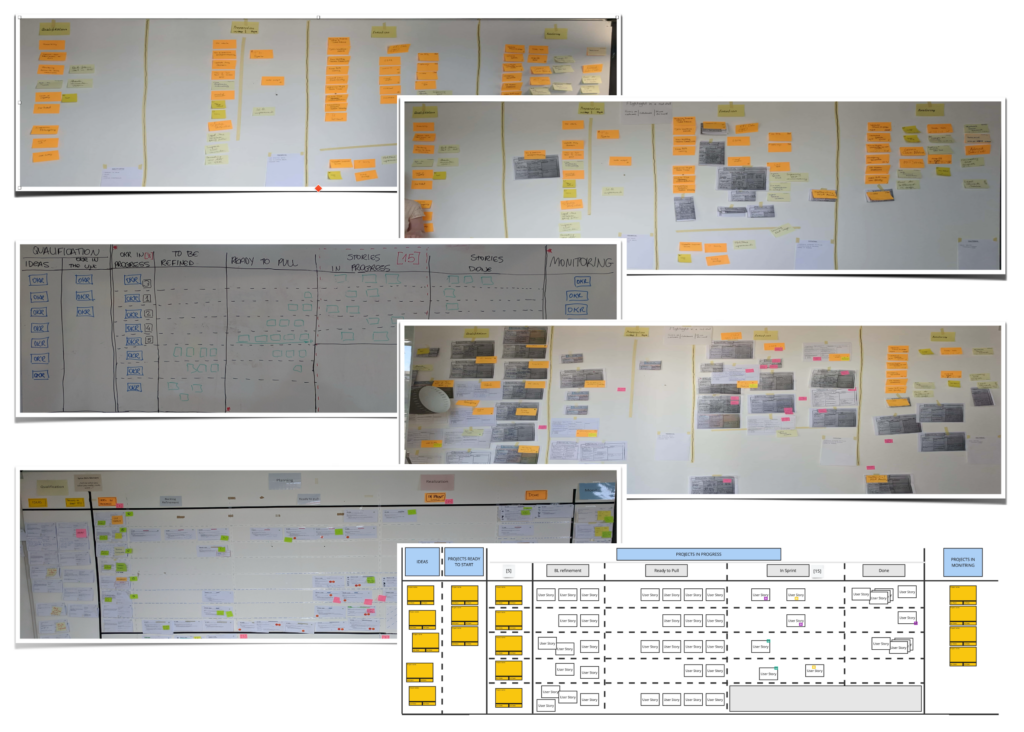
The evolution of the FL2 System over several months
As the Flight Level 2 System matured and demonstrated tangible benefits in terms of collaboration and transparency, its appeal began to resonate beyond the initial teams involved. The highly visual and interactive nature of the system soon caught the attention of other departments.
Initially designed to for product and technology, the system's transparency and ease of access made it an attractive tool for other parts of the organisation. Departments such as Marketing, Legal, Sales and Operations began to see how they could integrate into this system and transform their own work.
The pull towards greater visibility was natural and compelling. As other departments observed the successes, marked by increased project throughput and enhanced synergy across teams, they began to request inclusion in the Flight Level 2 System. This was not a forced integration but a voluntary and enthusiastic adoption, driven by the visible benefits and the promise of reduced silos and increased effectiveness.
As this expansion occurred the FL 2 System evolved with it. Areas were created where work from these departments could flow and be visible. The whole organisation could now see the tradeoffs that needed to be made and where the collective effort should to be focused.
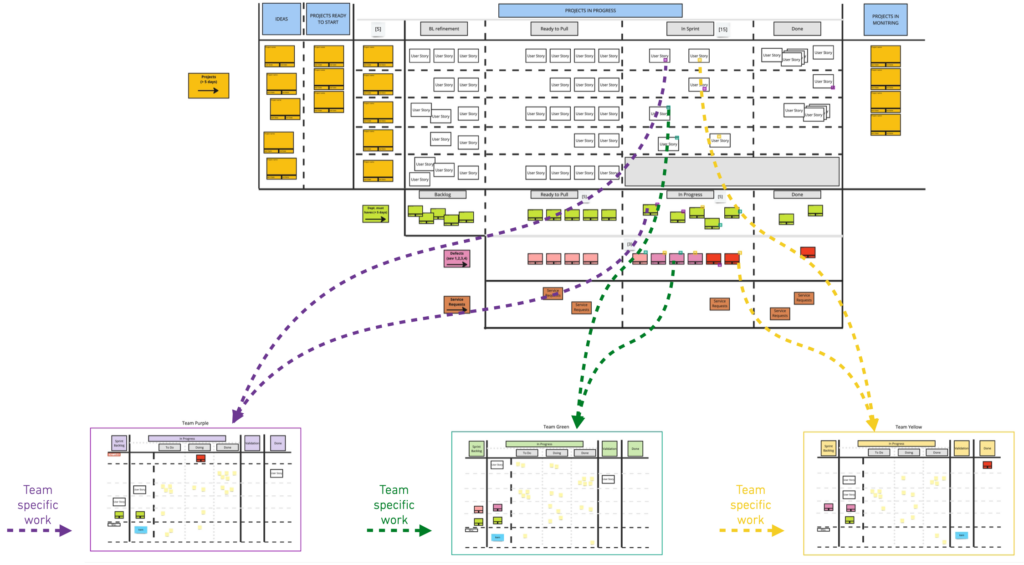
The FL2 System incorporating work from the entire organisation, and integration in to the team’s Flight Level 1 systems
As more departments integrated into the Flight Level 2 System, it evolved into a more comprehensive visual management tool that represented the entire organisation’s workflow. This unified system allowed for an unprecedented overview of all major projects and initiatives across the company, highlighting interdependencies and priorities that were previously opaque.
This broader adoption fostered a deeper organisational cohesion and a shared language. It allowed different departments to synchronise their efforts more effectively, align their objectives with company-wide goals, and shift effort fluidly between projects as priorities changed.
An Extra Note on Addressing Technical Debt
A critical challenge faced was the mounting technical debt; an accumulation that not only risked operational stability but also the ability to innovate. Under the new system, we took a proactive approach to this issue. By visualising the workflow and identifying bottlenecks, we were able to allocate specific effort to tackle technical debt directly. We introduced a policy whereby 50% of all projects funnelling through our Flight Level® 2 system were dedicated to resolving these debts. This strategy led to a dramatic reduction in system outages and significantly enhanced the overall robustness of the digital infrastructure.
As technical debt began to reduce, the flow of operations smoothed, leading to quicker turnaround times and fewer disruptions. This not only improved the internal efficiencies but also enhanced customer satisfaction as the reliability of services improved. Moreover, with the reduction of technical debt, teams were free to focus on innovation and development, pushing forward new projects that were previously sidelined.
Conclusion
As we conclude this transformational journey powered by Flight Levels®, it's clear that every company has chapters yet to be written. Whether you're a novice in the Agile world or a seasoned manager, there’s a lesson here. Visualisation, creating focus, people interacting, measuring progress, and then improving are not just elements of a successful business, they are the very pillars that can uphold it. Through this journey, we aim to inspire other organisations to embark on their own transformational paths, utilising the power of Flight Levels® to navigate challenges and elevate their operational effectiveness.
About the Author
Russell is a Flight Levels Coach and Accredited Kanban Trainer, who has worked with many organisations helping them to become better at what they do. He utilises mainly Flight Levels and Kanban in order to achieve significant organisational improvements, while focussing on building self-sufficient capability within the organisation.
Success Stories
Real Companies, Real Results
Discover how businesses of various sizes and industries worldwide have used Flight Levels to break down silos, align teams, and drive measurable success.